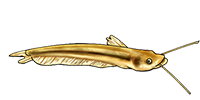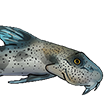Jools wrote: 30 Oct 2018, 21:10While we are on this subject, what's the current view on
versus
? We have them separate on the site but the ranges overlap and they are visually similar - what's differences do you see to keep them apart?
Those are good questions. From the original description,
is defined as a fish with relatively uniform small spots covering the body, the distance between spots being smaller than the diameter of the spots.
Ballen et al., 2016 wrote:Only a few species of Chaetostoma present a color pattern consisting of spots on both the head and the body (C. anale, C. daidalmatos, C. lineopunctatum, C. milesi, C. strompoulos, C. trimaculineum and C. vagum, (Lujan et al. 2015a; Salcedo 2006b). Chaetostoma joropo differs from these species except C. daidalmatos by having spots on the body that are (vs. space between spots larger or equal to spot diameter in C. anale, C. lineopunctatum, C. milesi, C. strompoulos, and C. vagum). Chaetostoma joropo differs from C. daidalmatos by having spots that are smaller than the orbital diameter (vs. spots larger than orbital diameter, (Salcedo 2006b). Finally, Chaetostoma joropo differs from C. milesi as follows: by having the spots on the head more densely packed together, with the space between spots smaller than spot diameter (vs. spots less numerous and with space between spots larger than spot diameter in C. milesi); by having more spots on body that are better organized in longitudinal rows (vs. spots less numerous and scattered in C. milesi); by the presence of scattered, numerous spots on the dorsal fin (vs. less numerous and always positioned anterior to each branched fin ray in C. milesi); by having a uniform black coloration on the dorsal surface of the pectoral spine (vs. with longitudinal row of spots on dorsal surface of pectoral spine in C. milesi); and by presenting undulated vertical bars on the caudal fin that transform progressively into spots (vs. caudal fin uniformly dark regardless of size in C. milesi).
In essence,
is defined by its body spot size and color pattern:
- The spots are numerous and densely packed, close together.
- The spots are small, "smaller than the orbital diameter."
- The spots are relatively uniform in size from head to caudal peduncle.
- The spots are more densely packed together on the head than on the body (but without altering spot size significantly to accommodate this more dense packing; this is evident on the photo series of juvenile, subadult and adult on the CLOG page).
- Compared to other species, the spots on body are better organized in longitudinal rows.
- On the dorsal fin, there are numerous spots randomly arranged, scattered.
- On the pectoral fin, there is a uniform (not spotted) black coloration of the dorsal surface of the pectoral spine.
- On the caudal fin, there are undulated vertical bars that transform progressively (with age) into spots.
In particular, the spotting pattern of
C. joropo is very specific.
fails to match a number of these points.
If I were to describe
L445 I'd describe it this way (based on the original DATZ photo):
- The spots are numerous but variable in size and spacing.
- The spots are smaller on the head (smaller than orbital diameter) and get progressively larger towards the caudal peduncle (equal to or exceeding orbital diameter).
- The spots are more densely packed on the head (space between spots less than spot diameter), and progressively spread apart on the body towards the caudal peduncle (space between spots equals or exceeds spot diameter).
- Our photos of the dorsal fin are insufficient for generalization, but appear to show spots anterior to the fin rays. (this is well shown on the original DATZ photo of L445)
- From our photos of pectoral fin, dorsal surface of the pectoral spine appears similar to C. joropo, or may present as a series of broken black areas.
- From our photos of the caudal fin, the tail appears to be similar to C. joropo. although I don't know if the variation shown in our pics varies with age: undulating vertical bars that transform progressively (with age) into spots
Certain to compound the confusion, I asked the author Ballen to examine all the photos we have posted on the CLOG page for
L445. He believes that the photos we have on that CLOG page represent at least 3-4 species, but did not elaborate further; I suspect he meant
C. joropo,
L445 and other undescribed forms. I believe he means this:
- C. joropo (7?, 12? 13?, 16?, 18?, 19)
- L445 (Figs 1, 2, 5, 6, 8, 10, 11, 14, 15, 20?)
- Possible other forms (Fig 3, 4, 9, 17)
As you can see from my question marks, I'm not even sure which fish belong where. Some fish look to be intermediate between
C. joropo and
L445. Conversely, some of the fish have essentially no spots on the head; but perhaps this is just due to stress or tank conditions.
There is a line in the Ballen et al. paper that would suggest that
L445 is just a juvenile
C. joropo:
Juveniles present an almost plain color pattern with few large blotches that become
progressively smaller until transformation into more numerous spots better organized in rows
Their text refers to the photo series presented in the paper. So perhaps color pattern is just an ontogenetic development from L445 to the small spotted adult
C. joropo. However,
- The juvenile in the article's photo is not a very good match for many of the L445 photos on our CLOG page.
- Just because juvenile spot size might start larger and get smaller with age, neither their published photos nor their text indicate either that the spacing between spots should increase with age (it does vary slightly towards the tail in the article photo, but not much) or that the spot sizes vary from head to tail (spots sizes from head to tail are almost uniform, even on the juvenile); furthermore, their juvenile does not resemble the subadult L445 I've seen in LFS stores (by "subadult" I mean large enough to sex, usually 60+mm SL).
- If L445 was simply a juvenile C. joropo, I would have expected Ballen to recognize this and say so when he examined the photos on our L445 CLOG page. But instead, Ballen concluded that the L445 CLOG page shows at least 3 species.
Perhaps
L445 and all the other odd fish shown are just regional variants of
C. joropo; honestly, I can easily imagine that to be the case. But the original description of
C. joropo (including the description of a number of other type and nontype specimens) did not leave room for that variation in its very narrow wording (unless we can go by the brief comment about development).
Cheers, Eric








